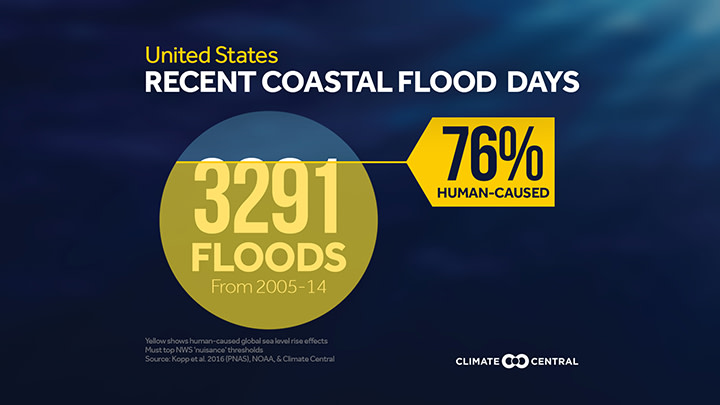Sea level around the globe has risen about 8 inches since 1900, and three-quarters of that rise can be traced to human-caused warming. This rise has brought an increase in the frequency of coastal flooding to the U.S., especially in the last decade.
Relatively smaller coastal floods that do not involve storms — often referred to as “nuisance“ flooding by NOAA or “sunny day” flooding — have sharply increased in the last 10 years across the U.S. Even in the absence of overwhelming property damage, these recurring floods still close coastal roads, overwhelm drainage systems and damage coastal infrastructure. A Climate Central analysis of 27 U.S. coastal gauges over that time shows that climate change has had an impact on 76 percent of those flood days. The enclosed graphic focuses on the 23 locations analyzed on the East and Gulf Coasts, where climate change impacted 74 percent of the flood days at those sites.
Impacts from these floods are worsened during the king tides, the highest astronomical tides of the year. King tides occur when the earth, moon and sun are in perfect alignment, maximizing the gravitational pull on the water. For many locations along the Atlantic and Gulf of Mexico coasts, they happen every October.
For some spots, the human influence is particularly dramatic: in 11 places, ranging from Key West, Fla. to Wilmington, N.C., more than 80 percent of nuisance flood days in that 10-year span can be attributed to human-caused sea level rise. And in both Honolulu and Fernandina Beach, Fla., all of the nuisance flood days (138 days and 16 days, respectively) between 2004-2015 were made possible by climate change.
With scientific projections of an additional three feet of sea level rise by the end of the century, today’s king tides may resemble regular high tides in the decades to come, meaning the current king tides provide a glimpse into a watery future. The greenhouse gas emissions we continue to pump into the atmosphere today are committing us to more dramatic changes in our coastlines. If global temperatures are restricted to even just 2°C (3.6°F) higher than the pre-industrial average — the globally agreed upon limit in the Paris Climate Change Agreement — sea level rise could eventually reach 20 ft, globally, as a result of the added heat.
Here’s a link to the full Climate Central report about king tides and human-caused sea level rise >>
